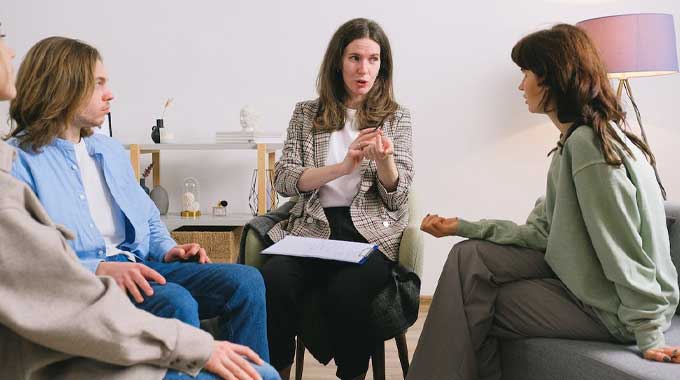How to Help a Loved One With Addiction

Substance Use Disorders
Addiction – or substance use disorder – is characterized by relapsing, uncontrollable use of a substance despite its negative impact on a person’s life. The condition changes the chemical makeup and structure of the reward and decision-making centers of the brain, causing sufferers to be trapped in a loop of drug or alcohol consumption.
This powerful and complex disease can halt a person’s life in its tracks, as well as the people around them. It is fairly common in the USA, with over 40 million people living with a substance use disorder in 2020 according to the Substance Abuse and Mental Health Services Administration (SAMHSA).
Symptoms of Substance Use Disorders
Although addiction has specific signs and symptoms depending on the exact substance being abused, generally, someone with a drug or alcohol addiction will:
- Experience intense drug cravings
- Express wanting to stop their alcohol or drug abuse but not being able to
- Experience withdrawal symptoms if the drug is not regularly taken
- Push away from their close relationships
- Not be able to uphold responsibilities in their personal lives
- Neglect their appearance: lack of interest in clothing, grooming, or looks
- Avoid places that they cannot drink
- Encounter problems at school or work: not turning up, drop in performance
- Gain physical and mental health issues
- Experience changes in weight, appetite, or sleeping schedule
- Be secretive about who they are with, what they are doing, or with their possessions
- Change their social circles
- Lose interest in activities they used to enjoy
- Encounter new monetary issues
- Make sure they maintain a supply of the drug
- Get into legal trouble e.g. driving under the influence, stealing
- Partake in risky behavior

The Role Loved Ones Play in Addiction
Addiction is described as a family disease, spreading through the entire unit and creating harmful coping mechanisms in each person. Living with someone with a substance abuse problem can be very emotionally challenging, with their behavior being unpredictable and erratic. This commonly leaves family and friends confused and traumatized and can push them to their breaking point.
It is extremely difficult to watch someone you love experience an alcohol or drug addiction and can feel like nothing you do makes a difference. Learning more about the disease and how you can help your loved one can help steer them onto the road of recovery. However, there is a fine line between attempting to help and enabling an addiction further.
Many friends and family members unknowingly and unintentionally support drug abuse through the thoughts and behaviors they play out. Despite a person’s good intentions, the longer the addicted party is enabled by those around them, the longer their condition will carry on.
Codependent Relationships
Codependency is a way to describe a highly dependent relationship between two people and is extremely common between those who have an addiction and their loved ones. Here, the actions of one person will enable, support, and help maintain the destructive drug-taking behavior of the other.
Codependency seemingly starts off as being helpful. For example, a person’s child may move in with them as they have lost their job due to their addiction. Although this behavior comes from wanting to be helpful and present for their loved ones, in the long run, this can exasperate the condition further and hurts them.
As time goes on, this one-off favor can transform into becoming the norm. The addicted person develops expectations that their codependent loved one will help them out of difficult situations each time they come across them. The enabler may think they are helping them, but they are only exacerbating the overall issue.
What is Enabling?
In essence, enabling is shielding a person from the full consequences of their drug use. It is natural to want to protect our loved ones from hardship, especially if they are going through a difficult time already. However, this well-intentioned approach can create opportunities to carry on their substance-taking behavior.
Examples of enabling behavior include:
- Ignoring unusual behaviors in the hope they will stop doing them alone
- Not reporting harmful or dangerous acts because of the potential implications, such as stealing from loved ones
- Making excuses for the person’s behavior to others, such as missing social events or phoning in work sick for them
- Supplying the person with money they claim to need for something – e.g. rent, food – when it is clear they will use it to fund their addiction
- Cleaning up the mess they have made before they sober up – such as if someone has thrown up over themselves

The Six Roles of Family In Addiction
To cope with the stressful environment that addiction causes, family members tend to adapt to one of these six dysfunctional roles. Sharon Wegscheider-Cruse – an expert in addiction and dependency – was the first to theorize these roles, observing common patterns of behavior in a wide range of families. In some cases, people fill multiple of these roles and at other times certain ones are left vacant.
- The addict: the addict is the one dealing with addiction and becomes the focal point of the family. If they realize it or not, most of the efforts and attention of the group will be directed toward this individual. The addict will take up family members’ money, time, and energy. Loved ones regularly enable this person’s behavior to maintain the status quo and try and make it easier for everyone else.
- The hero: this family member will enable the addict the most by putting their time and energy into maintaining the status – both inside the unit and how it looks to others. The hero will try and keep dysfunctional behavior to a minimum, but this only ends up covering up the real problem. This person is usually a perfectionist, over-responsible and self-sufficient.
- The caretaker: this person directly enables the addict by trying to solve and clean up the mess the addict causes through their substance abuse. This person sees themselves as a martyr and spends a lot of their energy trying to make sure each member of the family is balanced. This only shields the addict from facing up to the consequences of their situation and allows the dysfunctional cycle to continue.
- The scapegoat: this person usually provokes negative attention to distract the family from the addict’s behavior, acting out of defiance and hostility. They provide a false sense of control over the situation and divert attention from the true source of the problem.
- The mascot: through humor, the mascot aims to relieve tension and stress from the situation. The mascot tries to stay in constant motion to stop the chance of slowing down and fully comprehending the reality of the situation. This attempt to help their family actually only enables the addict’s behavior further.
- The lost child: this family member tries their hardest to blend into the background and stay out of the way of other family members. The lost child will let others take the spotlight to spend as little time as possible in the center of the chaotic family structure.
How to Help A Loved One Overcome Addiction without Enabling Them

Stopping codependency and enabling behavior can be extremely difficult, as this way of dealing with the situation can become second nature and very subtle. The best approach to breaking down these habits is to heal the family unit as a whole by following these tips.
Show Compassion
It is sometimes hard to show compassion to a person that may have hurt you, but this can be essential in helping your loved one move past their addiction. Be as patient as possible with them, remembering they are acting this way due to a mental health condition they are experiencing. It’s also important to show compassion towards each member of the family.
Try to Get the Whole Family on Board
Although this is not possible every time, getting most of the family committed to stopping enabling the drug taker’s behavior means a higher chance of success. If one family member carries on bailing the addicted person out or giving them money, they will have less need to face up to their reality.
Hold an Intervention
An intervention can seem like a daunting process to go through, but it can be extremely successful to motivate someone to seek professional help for their alcohol or drug abuse. It can be hard for someone with an addiction to see and acknowledge that they have a problem, with many people dealing with the disorder being in denial and refusing to seek addiction treatment. However, the unity of multiple loved ones coming together and expressing their concern and love for a person can be extremely powerful.
Interventions are usually planned by family and friends, with the help of a mental health professional. People that care for the addicted person will attend the intervention and explain the impact their substance use disorder has had on their life. It is advised that an outside addiction specialist is present during the process to mediate it and keep the discussion on track.
Go to 12-Step Program Family Meetings
As people dealing with substance abuse have the opportunity to attend educational and support groups, so do families dealing with the condition. Attending 12-Step family meetings allows people to understand enabling habits and address them as a whole. Being able to spot the signs of codependency and enabling is the first step to banishing them from your life.
Attend Family Therapy Sessions
Family therapy allows for underlying issues that may be contributing to the addict’s drug taking and the rest of the family’s enabling behaviors to be realized and addressed in a safe environment. Having a therapist present can ensure each person feels heard and the conversation stays on topic. Some people find it easier to open up with a neutral, unbiased third party, helping get more rapidly to the real issues at hand.
These sessions can also help addicted people and their family members to separate the disease and its actions from the individual carrying them out, which can be extremely insightful and evoke understanding. Through family therapy, communication can be improved, trust can be established and unhealthy behaviors can be broken down, allowing everyone in the unit to have more fulfilling relationships with one another.
Break Enabling Habits
Although it is difficult, it is vital that the family breaks their enabling habits for the sake of the whole unit. During this time, it is important to be firm and not indulge the addicted person’s detrimental behavior.
Encourage Them to Seek Treatment
Overcoming a drug or alcohol addiction is a difficult challenge and without professional medical support, the chances of a safe and successful recovery are a lot lower. Encouraging a loved one to attend a rehabilitation treatment program can plant a seed in their mind and push them to take the right step forward.
Commit to the Ongoing Addiction Recovery Process
Even after attending rehab, battling addiction is a lifelong process for everyone who was touched by the condition. Certain triggers may be caused or amplified by family members’ behavior, so it’s important to be cautious and mindful of these. Ongoing therapy sessions are vital for the whole family to continue to learn healthier, more positive ways of interacting with each other.
Long-term recovery support for each person in the family can look different. Some people might attend regular support groups, attend occasional therapy sessions, donate to a charity for addiction, or help other people out who are currently going through addiction in the family. What matters is each person’s own well-being is being looked after and the trauma caused by addiction is reviewed every so often.
Expect Difficulties
Throughout all of these stages, there are going to be road bumps along the way. Relapse and denial are part of the nature of addiction and it is probable your loved one will go through cycles of these during the process. However, this is not a sign that all hope is lost with the future likely being much brighter.
Care for Yourself
Throughout all of these stages, it is vital that you remember to care for yourself and your loved one’s needs do not always come before your own. Being a caregiver can be extremely stressful and emotionally draining, so taking some time for your own well-being is essential for everyone in the family unit.

What to Expect When a Loved One Receives Treatment
After a loved one has agreed to attend a treatment program to deal with their addiction it can be helpful to know what to expect. An inpatient rehabilitation program may last for a few months, though long-term treatment can take years. As already mentioned, expecting some setbacks during this process can be useful to keep up motivation and optimism for the future.
Due to the complexities of each individual’s brain and life experiences, treatment for addiction is highly individualized, so until the person’s plan has been laid out it is uncertain exactly how it will look. In general, medical detox is nearly always the first step toward recovery. This is where the person struggling with addiction will stop taking the substance in a medically supervised environment to ensure a safe and successful recovery.
After this comes attending a rehabilitation center or program, where various kinds of therapy will be offered to the recovering party. The most commonly used method is cognitive behavioral therapy (CBT), which aims to identify triggers and build new healthier ways of dealing with them.
Learning more about your loved one’s disorder, treatment options and needs is a great way to offer them support. This can be done through a quick internet search, asking them directly or contacting a trained professional for advice. Simply offering to help with immediate needs – such as driving them to appointments or attending group meetings with them – can be the exact support they need to keep going on their recovery journey.
Leaving or Letting Go of Someone with an Addiction
Unfortunately, not every person can be helped and wants to seek treatment. Substance use disorders are complex and intense diseases and not everyone can confront theirs when you may need them to. Families can hold countless interventions and try all the techniques mentioned above but unless the person accepts they need addiction treatment and commits to the lifelong fight against the disorder, it is out of your hands.
Drug and alcohol abuse also commonly changes people’s personalities in negative ways – such as increased levels of anger, resentment, irritation, confusion, and violence. Here, parents, children, partners, siblings, and friends are often subjected to emotional and physical abuse. It’s important to reflect on when enough is enough for the sake of your own life and mental health. Many family members put their lives on hold for their loved one’s addiction for many years, though the day may not come when they accept they need help.
Although you do not have control over the person’s actions, you do have control over being able to remove yourself from a toxic situation. This is especially advised if children are involved, as experiencing a loved one live with substance abuse as a child largely increases the risk for developing an addiction or another mental illness in later life.
Contact Us
At Brookdale, we understand how addiction can impact the lives of everyone around it. That is why our team of expert professionals is here to help the whole family through this difficult time, helping rebuild each person and the family unit as a whole. Please do not hesitate to contact us for more information about our individualized, evidence-based approaches to treating addiction and its after-effects.

